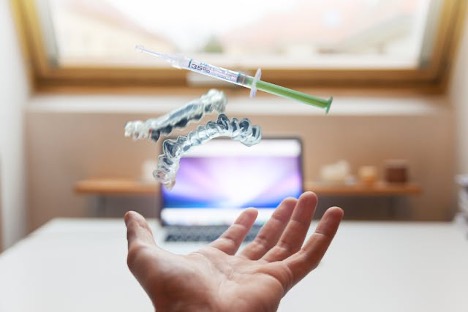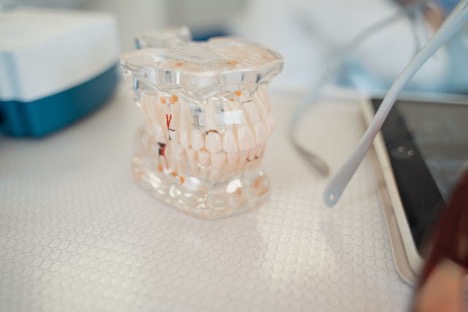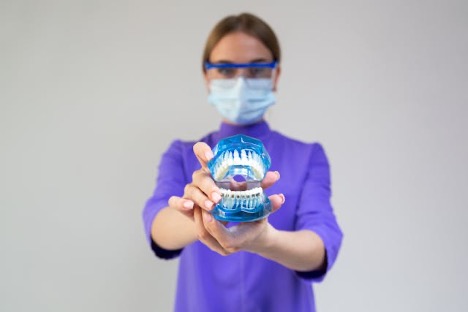
01 Oct The Latest Advancements in Dental Crowns: How Innovative Materials and Techniques Are Improving Oral Health Outcomes

Innovation in dental crowns is not just a matter of aesthetic enhancement—it’s a game-changer for oral health outcomes. As technology evolves, so does our ability to restore and enhance dental health through more sophisticated and tailored treatments. Recent advancements in dental crown technology are transforming what it means to receive a crown, making the procedures quicker, more accurate, and far less intrusive than ever before.
These innovations extend beyond mere improvements in materials or techniques; they redefine the patient experience and elevate the standard of care provided. By integrating cutting-edge materials with state-of-the-art fabrication processes, dental professionals can now offer solutions that look remarkably natural, function better, and last longer. This leap in dental technology not only enhances the efficiency of treatments but also significantly improves the overall oral health outcomes for patients across the globe.
Innovative Materials in Dental Crowns
The materials used to make dental crowns have advanced significantly, making them more visually attractive, biocompatible, and long-lasting than before. Let’s explore some of the cutting-edge materials that are setting new standards in dental restorations.
Zirconia and Lithium Disilicate:
Regarding modern dental crowns, zirconia and lithium disilicate lead the pack. Zirconia, known for its diamond-like strength, is exceptionally durable, making it ideal for back teeth with the greatest bite force. Its robustness doesn’t come at the expense of aesthetics; zirconia crowns mimic the natural translucency of tooth enamel, blending seamlessly with your natural teeth. Lithium disilicate complements this with its glass-like appearance, offering an optimal balance of strength and beauty. This material is particularly favored for its lifelike shine and ability to be tinted to match neighboring teeth, ensuring that crowns are virtually indistinguishable from natural dental structures.
For those interested in exploring the possibility of receiving a state-of-the-art dental crown, modern technology and materials can provide unprecedented benefits in terms of durability, aesthetics, and overall dental health.
Both materials are highly biocompatible, minimizing the risk of allergic reactions and ensuring they interact harmoniously with the body. This makes them excellent choices for patients looking for long-lasting dental solutions that also maintain the natural health of their oral environment.
Hybrid Materials:
The evolution of dental materials has also led to the creation of hybrid materials, which combine the best features of traditional ceramics and composite resins. These hybrids are engineered to provide ceramics’ resilience and long-term durability with the fine, detailed aesthetics of composite resins. These materials are notable for their capacity to reflect light in a manner akin to that of natural tooth enamel. For restorations on the front teeth, where a natural appearance is most evident, this trait is essential.
Hybrid materials are not only about looks; their composition allows for better wear resistance and less susceptibility to chipping than older materials. This makes them a versatile option for both anterior and posterior crowns, catering to patients’ functional and cosmetic needs.
Introducing these innovative materials in dental crowns is a testament to how far dental technology has come. Not only do they offer improved physical properties, but they also ensure that the restorations are indistinguishable from natural teeth, enhancing both the function and aesthetics of a patient’s smile.
Technological Advancements in Dental Crown Fabrication

Creating dental crowns has dramatically evolved with new technologies, significantly enhancing the precision of dental restorations and the comfort of the patient experience.
3D Printing:
Stereolithography (SLA) technology is one of the most innovative developments in the manufacturing of dental crowns. With this type of 3D printing, liquid resin is cured layer by layer into hardened plastic using a laser, enabling precise fit and great attention to detail. The precision of SLA technology ensures that each crown is tailored to the specific contours of the patient’s tooth and matches the adjacent teeth’ natural appearance. The ability to rapidly prototype and produce a crown within hours reduces overall turnaround times from what could traditionally take weeks to potentially the same day. This efficiency maximizes convenience and decreases the time a patient spends in the dental chair waiting for a crown to be completed, often making multiple visits unnecessary.
CAD/CAM Technology:
Computer-aided design (CAD) and computer-aided manufacturing (CAM) technologies have similarly transformed the landscape of dental crown production. This technology streamlines crowns’ design and creation process by using digital imaging to map out the area of the mouth being treated and then crafting the crown via precision milling machines. The result is a highly accurate and durable crown, customized to fit the patient’s mouth with minimal adjustment needed. CAD/CAM technology not only ensures a better fit but also significantly enhances the strength and longevity of the crown. Moreover, by reducing the need for physical impressions, which can be uncomfortable for the patient, and cutting down on manual adjustments and remakes, CAD/CAM increases overall patient comfort and satisfaction.
These technological advancements in dental crown fabrication represent a leap forward in dental care. By integrating SLA 3D printing and CAD/CAM systems, dental practices can offer quicker, more accurate, and more pleasant patient experiences, ultimately leading to better dental health outcomes and higher patient satisfaction.
Minimally Invasive Techniques
The push towards minimally invasive dentistry has led to significant developments in the technologies and materials used, particularly in creating and placing dental crowns. These advancements simplify the procedure and enhance the healing process and overall dental health.
CEREC Technology:
In terms of dental crown technology, Chairside Economical Restoration of Esthetic Ceramics (CEREC) is a breakthrough. With the help of this cutting-edge technology, dentists may plan, make, and fit ceramic dental crowns in a single appointment. Using 3D scanning technology, CEREC captures precise digital images of the damaged tooth, eliminating the discomfort and inaccuracies of traditional dental molds. The digital model is then used to design the crown on a computer screen in real time. The same equipment, which takes weeks to create crowns in a lab, can quickly cut a crown from a ceramic block once the design is completed. This streamlined process saves time and reduces the patient’s exposure to temporary fittings, which can be uncomfortable and less effective.
Bioactive Materials:
Using bioactive materials in dental crowns is another advancement in improving patient outcomes. These materials, including bioactive glasses and ceramics, are designed to interact positively with natural tooth structures. Unlike traditional inert crown materials, bioactive materials can promote tooth enamel regeneration and support the tooth’s natural healing process. They form a chemical bond with the tooth, facilitating the exchange of essential minerals that help restore tooth integrity and prevent further decay. This bioactivity may lessen the need for additional dental procedures by preserving the tooth’s natural appearance and function.
CEREC technology and bioactive materials embody the trend toward less invasive dental treatments. By focusing on efficiency, patient comfort, and enhanced biological compatibility, these technologies are setting new standards for dental restorations, ensuring patients not only look good but also have healthy teeth.
Improving Dental Health and Oral Hygiene

Integrating advanced materials and technologies in dental care revolutionizes managing dental health and oral hygiene. New materials used in dental crowns, such as zirconia and lithium disilicate, offer superior fit and finish compared to traditional materials. This exact fit improves comfort and lowers the risk of bacteria accumulation under the crown, which is a typical problem with poorly fitted restorations and can cause gum disease and decay. These materials are also renowned for their extraordinary endurance, withstanding a great deal more wear and tear than previous varieties of crowns. Because of its durability, crown replacements occur less frequently, which is advantageous for preserving the integrity of the tooth structure over time.
Moreover, the ease of maintenance with these new materials encourages better oral hygiene. Crowns designed from advanced ceramics or hybrid materials are smoother and more resistant to staining and plaque accumulation, making daily cleaning more effective and helping to sustain oral health. Together, these improvements in dental crown technology contribute significantly to patients’ overall well-being, promoting healthier mouths with fewer complications.
The Role of AI and Digital Tools
Artificial intelligence (AI) is playing a transformative role in dental practices, bringing about precision and personalization that were previously unattainable. AI enhances diagnostic accuracy significantly; for example, algorithms can analyze X-ray images and detect subtleties that might escape the human eye, identifying early signs of conditions like cavities or gum disease before they become severe. This early detection is crucial in preventing extensive dental damage and planning more effective treatments.
Furthermore, AI contributes to the customization of dental treatments. Using vast amounts of data, AI tools can predict treatment outcomes, allowing dentists to tailor their approaches to their patients’ individual needs and conditions. This not only ensures optimal treatment effectiveness but also enhances patient satisfaction by delivering predictable and favorable results. The application of AI in dentistry not only streamlines workflow but also elevates the standard of care, leading to improved health outcomes and more efficient dental practice operations.
Future Outlook
The future of dental crown technology is brimming with potential, thanks to continuous advancements in material science and 3D printing techniques. Researchers are developing new materials that mimic the natural properties of dental enamel and incorporate functionalities such as anti-bacterial properties and enhanced biocompatibility. Meanwhile, 3D printing is expected to evolve further, reducing costs and improving the speed and precision of dental crown fabrication. These innovations promise to make dental treatments even more effective, accessible, and personalized shortly.
Conclusion
The advancements in dental crown technology have been nothing short of transformative. With the introduction of superior materials like zirconia and lithium disilicate, alongside innovative fabrication techniques such as 3D printing and CAD/CAM, dentistry has seen a significant enhancement in the quality and efficiency of treatments. These developments improve the patient experience by offering quicker, less invasive procedures and elevating the overall standard of dental care. As we look forward to further innovations, dental professionals and patients alike need to embrace these technologies to ensure the best possible oral health outcomes.
——————–
The information on MedicalResearch.com is provided for educational purposes only, and is in no way intended to diagnose, cure, or treat any medical or other condition.
Some links are sponsored. Products, services and providers are not tested, warranted or endorsed.
Always seek the advice of your physician or other qualified health and ask your doctor any questions you may have regarding a medical condition. In addition to all other limitations and disclaimers in this agreement, service provider and its third party providers disclaim any liability or loss in connection with the content provided on this website.
Last Updated on October 1, 2024 by Marie Benz MD FAAD
